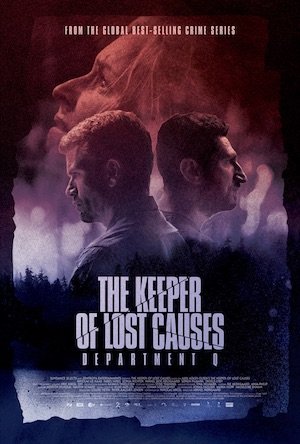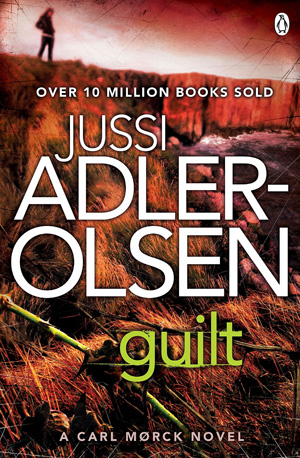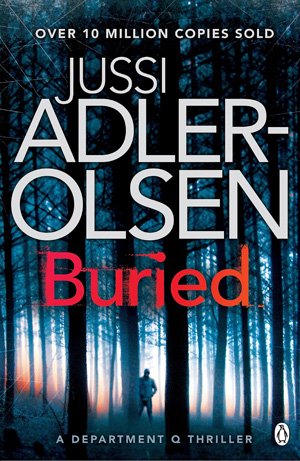When it comes to Nordic noir, you’re unlikely to find a series quite like Department Q. Conceived by Danish writer Jussi Adler-Olsen, these books are dark and unflinchingly brutal, full of social commentary, yet also manage big doses of madcap, laugh-out-loud humour. They have proven so popular that three of the stories have been shot as feature length films in Danish. What’s tricky about the series is that some of the books have two names – a US and a UK title. Hence, a guide is in order…
While each book has wonderfully twisted crimes for Copenhagen-based lead detective Carl Mørck to solve, it’s the well-drawn characters that appeal just as much as the dark doings and thrilling action scenes they’re involved in. You’ll be amused at the domestic travails of the beleaguered detective, and appalled at the viciousness of the villains he puts away with the help of his crack – or some would say cracked – team.
Carl Mørck is a brilliant detective, disheveled and unhealthy in body and mind, who wanders around police headquarters grunting like a nomad with a perpetual hangover. But don’t let appearances fool you. Carl has razor-sharp investigative instincts, despite being plagued by a range of personal issues. In the first book, we learn that Carl was involved in a police raid that turned into an ambush by unknown assailants. He was barely scratched, but one of his colleagues died, and his partner Hardy was left paralysed. Carl has lost the confidence of his superiors, and been pushed to the side. The government has asked the police to set up a division to investigate cold cases from all over Denmark. With disdain for the idea, the top brass put Carl in charge of it, syphon off most of the money, and give him a basement cupboard to work from. The shabby storage space becomes the official headquarters of Department Q.
 When the cold creeps in
When the cold creeps in
There’s a reason the cases on Carl’s desk have gone cold. They’re the most difficult cases Denmark’s police have faced. Alongside the intrigue of the investigations, the way Carl’s disastrous personal life unfolds is captivating. The gloomy, resigned detective must cope with visits from his erratic his ex-wife Vigga, while her teenaged son Jesper continues to live with Carl. He also takes in Hardy, because he feels so guilty about the man’s injuries. Hardy’s carer Morten eventually moves in too and ends up being the house mother while Carl is away. At work, he has an obstructive boss, and as his Department Q team grows they all turn out to be jaw-droppingly eccentric. Nevertheless, Carl’s band of misfits navigate the grunt work of reviewing cold cases with astonishing finesse and the department proves itself with a remarkably successful track record.
Let’s face it, Carl is not nearly as charismatic as Harry Hole. In the pantheon of Scandinavian detectives, he resembles more the down-and-out everyman Martin Beck, and that’s why we identify with him. He doesn’t come off as a natural leader, but his cynicism and wise-cracks seem to bring the best out of his team. They challenge his negativity, and often it’s the Department Q team that gets the best out of Carl rather than the other way around.
The first you’ll meet is Hafez el-Assad, who is actually a caretaker but appoints himself as Carl’s partner. He proves himself with sharp insights and old-world wisdom, not to mention an inexhaustible catalog of camel proverbs for every occasion. What he did in his Syrian homeland is a mystery, but he certainly knows how to fight and he makes lethal coffee. Each impressive skill he demonstrates raises new questions about his mysterious past. The next to arrive is Rose. Dressed in leather and heavily made up, it seems she’s lost the plot in her personal life. But she hits the ground running and soon proves herself with superb organisational and analytical skills. Out of the blue one day, Rose’s twin sister Yrsa appears, and her code-breaking ability comes in handy for a case. Just as quickly, Yrsa disappears again and it turns out she was not all she seemed. Later in the series, Carl’s hated new boss assigns Gordon Taylor to the team. Tall and rangy, he’s a rookie whose real purpose is to keep tabs on the department. He seems adept at botching his investigative work, and has the hots for Rose. As the series progresses, it seems likely that the backstories of each team member will come into sharper focus.
Mercy (Kvinden i buret – 2007)

Released as Mercy in the UK, and as The Keeper of Lost Causes in the US, the first book in the series lays a strong foundation. An operation that went disastrously wrong – leaving one colleague shot dead and another, Hardy, permanently paralysed – hangs heavily over detective Carl Mørck both professionally and personally. He is quickly established as a cynical and sardonic figure, and to move him out the way he’s put in charge of a government initiative to solve historic cold cases – Department Q. Out of nowhere, Syrian caretaker Assad appears and becomes his assistant. But where Carl half-heartedly sifts through the case files, Assad is keen as mustard and soon the duo are investigating the disappearance of a promising young politician, Merete Lynggaard. Apparently she jumped off a ferry, but Carl and Assad soon think otherwise and part of the mystery involves unlocking the memories of Merete’s deeply troubled brother. Who made her disappear and why? The book earned five stars and Recommended status on our site when we reviewed the Penguin translation in 2011.
Buy now on Amazon
For the movie adaptations, Zentropa has kept the more intriguing American titles for most of the series. Department Q: The Keeper of Lost Causes came out in 2013 directed by Mikkel Norgaard of Borgen fame, and with Nikolaj Lie Kaas (Follow the Money) as Carl Mørck. He’s a bit more physically fit than the Carl you imagine from the books. The cinematography was by Eric Kress, whose influential lensing style for the Millennium trilogy made Scandicrime lovers of us all. Watch the trailer below, or view the full movie on Amazon.
Disgrace (Fasandræberne – 2008)

Released as Disgrace in the UK and as The Absent One in the US, the second book sees the addition of Rose Knudsen to the Department Q team. Mørck cracks open a new case, this time the murder of a brother and sister in the family home. The suspects here are a group of privately educated upper crust types, who turn out to be the worst examples of white privilege-cum-sadist. Two decades later, one of the group has died, one is a fashion designer, another a stockbroker, and a third man is a top plastic surgeon. Then there’s Kimmie. Half-mad, she lives on the streets, but if Carl can track her down the information she has makes her a liability for the old boy network, who want their past secrets to stay buried. They grow increasingly paranoid – and violent – and manage to pull some strings in the police. It’s not hard to see what the author thinks of the the way some rich and powerful people operate. As Carl gets his hooks into the past he races to find Kimmie, who is in survival mode, before the corporate alpha mafia silence her for good. As Carl tries to keep his personal life under control he even ventures into romantic territory, but don’t hold your breath, a normal life is not in the cards for the grumpy detective. Read our review of the Penguin translation, which came out in 2012.
Buy now on Amazon
The movie version was released in 2014 as Department Q: The Absent One, and you can see the trailer below or watch the full movie on Amazon.
Redemption (Flaskepost fra P – 2009)

Released as Redemption in the UK and as A Conspiracy of Faith in the US, book three proves that there’s nothing more romantic than a message in a bottle, unless it’s a harrowing cry for help written in blood by a captive child. After the bottle is discovered by British sailors, it eventually finds its way to Deptartment Q. When Rose fails to show up for work one day, her twin sister Yrsa fills in. Carl and his team are working all out to catch a serial killer with a gruesomely creative MO. He insinuates himself into reclusive religious sects, kidnaps two siblings for ransom, and then executes one in such a way that seals the family’s silence. Perhaps Adler-Olsen’s sickest and most memorable villain to date, the killer is a handsome and charming monster who leads a double-life, but it is his neglected wife who helps spur the investigation forward. Adding depth to the story, the killer is also being pursued by someone else. In the over arching storyline of Carl Mørck’s rehabilitation, he has fallen for police psychotherapist Mona Ibsen. With religion and religious zeal as themes, we gain a little more insight into Carl’s personality through his reaction to notions of faith. But it’s the killer in the story, and a superb chase sequence involving a train, that you’ll remember about this one. This book is excellent, and you can read our full review here.
Buy now on Amazon
Released as a film 2016 with Pål Sverre Hagen (Valkyrien) playing the villain, A Conspiracy of Faith was directed by Han Petter Moland, known for the excellent Norwegian movie In Order of Disappearance. Here’s the trailer:
Guilt (Journal 64 – 2010)

Published as Guilt in the UK and as The Purity of Vengeance in the US, book four reminds us of the old adage about revenge being a dish best served cold. The wronged party here is Nete Hermansen, a woman permanently damaged in her youth back in the 1950s, who later carries out her own form of vigilante justice. Her target is an arrogant group of eugenicists, particularly surgeon Curt Wad. The doctor was responsible for sterilising dozens of young women – mainly poor girls who’d fallen pregnant – on the small Danish island of Sprogø. Somehow, this is connected to the latest cold case Carl Mørck has picked up – the disappearance of a brothel owner named Rita in 1987. Together with Assad and Rose, he also looks into other disappearances around the same time. With frequent flashbacks to the heartbreaking struggles of Nete on the one hand, we also see Curt Wad in action in the present, leading the extreme right-wing Purity Party. While Mørck sorts out old mysteries, a shaft of light is shone onto the ambush that he and Hardy were involved in, as a body linked to the case is discovered. He must also negotiate the current mysteries within his own department. He and Rose puzzle over Assad’s background, and at the same time he works with Assad trying to establish Rose’s true identity. If that’s not enough of a headache, Mørck’s family troubles continue because now his own cousin is trying to frame him. Read our review of the Penguin translation in 2014.
Buy now on Amazon
The final movie adaptation, entitled Journal 64, came out in 2018 and you can watch the trailer below.
Buried (Marco Effekten – 2014)

Released as Buried in the UK and as The Marco Effect in the US, the fifth Department Q book lands us in the underbelly of Copenhagen where a group of Romani youth wander the streets looking for a mark to pickpocket. Meanwhile, 5,000 miles away an aid worker in Africa texts a final coded message before being executed by a Scandinavian syndicate that has been embezzling funds through humanitarian organisations. When young thief Marco, who hopes for a better life, unintentionally stumbles across their nefarious plans, suddenly his life’s not worth a plug nickel and the chase is on. It is Rose who happens upon a connection to the corrupt bankers behind the conspiracy while investigating a missing persons case linked to Marco. Carl Mørck and his band must rush to reach the young thief before the bad guys do. Meanwhile, back at the base, Carl’s hatred for the police hierarchy reaches a new level when his new boss sends clueless rookie Gordon Taylor to join Department Q. Although Rose proves her investigative mettle, she confounds Carl by romancing Gordon. But more mystifying still is Assad, who is somehow connected to Carl’s new chief via the Iraq War. And how’s Mørck’s love life going? Ask Mona, who preemptively dumps him before he can propose. Read our review of the Dutton translation in 2014.
Buy now on Amazon
The Hanging Girl (Den Grænseløse – 2015)

As seen in Redemption, the theme of religious zeal returns with a new age cult taking centre stage. This time, Carl Mørck and his colleagues take on a case that has stymied a retired policeman for many years: that of a beautiful teenage girl called Alberte Goldschmid. She was struck by a vehicle, throwing her body up into a tree, where she died. Shockingly, the retired policeman takes his own life when Mørck initially turns down the case. Out of guilt, and with some hectoring from Rose, eventually he steps up to the mark. It turns out the girl fell under the spell of charismatic cult leader Atu Abanshamash Dumuzi a little while before she died, and was secretly in love with him. With the cult having relocated to the Swedish island of Öland, solving the case becomes something of a road trip for Mørck and Assad, and it also turns into a race against time. As we learn more about Atu and his Finnish devotee Pirjo, it becomes clear that Alberte’s death isn’t the only one associated with the cult, and someone is being held captive in their compound as the story unfolds. Mørck’s family background is explored, we now learn that Rose has some kind of multiple personality disorder, and there are many more extraneous story strands. Thus it is the longest book in the series – too long perhaps – and you can read our full review here.
Buy now on Amazon
The Scarred Woman (Selfies – 2017)

Released in September 2017 in both the US and UK, The Scarred Woman gives us a lot more insight into the character of Rose, who appeared one day to become Carl Mørck’s assistant and never left. You can read our full review here. The story opens with the corpse of an elderly lady found in circumstances remarkably similar to another case in the Department Q files. Meanwhile, a group of young women who receive state benefits in Copenhagen are being brutally hunted. Is there somehow a connection between these acts of violence against women – young and old? As they work to solve the case, Carl, Assad and Gordon also need to support Rose, whose troubled and violent past re-emerges in the most dramatic of ways.
Buy now on Amazon
The Department Q series is dark, brutal and funny. For a more serious and existential brand of Scandinavian crime fiction, we recommend Arnaldur Indridason’s Erlendur series. If you want to go old school, try the Martin Beck series or, for more action, you must meet Harry Hole.










This series has been on my TBR and review list for some time and I really appreciate the wonderful guide!
Thank you for the recap. I absolutely love these books. When is the next Dept Q book coming?? The Marco Effect, was my favorite. I like Morck much more than Harry Hole. Carl, Assad & Ruth are such a perfect fit of brainy misfits ever! The movies don’t seem to catch that funny witty side of Carl, just the dark side. If you have Mr Adler-Olssen’s ear, please please beg him for more Dept Q!! Thanks…
Excellebt feature atticle as always from CFL. thanks!
Thank you!
I have read them all and totally recommend it!
Love the CD version of all Dept. Q’s series. Reader is exceptional. When is the next Dept. Q book coming out and hopefully on CD with the same reader. One of my favourite authors.
When are some more Dept Q coming.Didn’t like stand-alones AT ALL!!
Just love Dept Q, Carl & Assad! Is there another Dept Q book in the pipe?? Dept Q junkies are dying here!! Mr Adler-Olsen, please help us out..you are the best!!!
I love this series. I watched the first 3 movies on Hulu as well. Great movies as well. Then books kept coming but the movies with English subtitles stopped so sad.
Do we know what Carl Morck looks like?
He has more recently added two more in the Department Q series:
– Victim 2117: In the heart-pounding next installment of the New York Times and #1 internationally bestselling Department Q series, a terrifying international investigation reveals the complex backstory of one of the department’s own—the enigmatic Assad.
The newspaper refers to the body only as Victim 2117—the two thousand one hundred and seventeenth refugee to die in the Mediterranean Sea. But to three people, the unnamed victim is so much more, and the death sets off a chain of events that throws Department Q, Copenhagen’s cold cases division led by Detective Carl Mørck, into a deeply dangerous—and deeply personal—case. A case that not only reveals dark secrets about the past, but has deadly implications for the future.
For troubled Danish teen Alexander, whose identity is hidden behind his computer screen, the death of Victim 2117 becomes a symbol of everything he resents and the perfect excuse to unleash his murderous impulses in real life. For Ghaalib, one of the most brutal tormentors from Abu Ghraib—Saddam Hussein’s infamous prison—the death of Victim 2117 is the first step in a terrorist plot years in the making. And for Department Q’s Assad, Victim 2117 is a link to his buried past—and the family he assumed was long dead.
With the help of the Department Q squad—Carl, Rose, and Gordon—Assad must finally confront painful memories from his years in the Middle East in order to find and capture Ghaalib. But with the clock ticking down to Alexander’s first kill and Ghaalib’s devastating attack, the thinly spread Department Q will need to stay one step ahead of their most lethal adversary yet if they are to prevent the loss of thousands of innocent lives.
– The Shadow Murders: In the exhilarating penultimate thriller of the New York Times and #1 internationally bestselling Department Q series, the team must hunt for a nefarious criminal who has slipped under the radar for decades.
On her sixtieth birthday, a woman takes her own life. When the case lands on Detective Carl Mørck’s desk, he can’t imagine what this has to do with Department Q, Copenhagen’s cold cases division since the cause of death seems apparent. However, his superior, Marcus Jacobsen, is convinced that this is related to an unsolved case that has been plaguing him since 1988.
At Marcus’s behest, Carl and the Department Q gang—Rose, Assad, and Gordon—reluctantly begin to investigate. And they quickly discover that Marcus is onto something: Every two years for the past three decades, there have been unusual, impeccably timed deaths with connections between them that cannot be ignored, including mysterious piles of salt at the scenes. As the investigation goes deeper, it emerges that these “accidents” are in fact part of a sinister murder scheme.
Faced with their toughest case yet, made only more difficult by COVID-19 restrictions and the challenges of their personal lives, the Department Q team must race to find the culprit before the next murder is committed, as it is becoming increasingly clear that the killer is far from finished.
https://www.fantasticfiction.com/a/jussi-adler-olsen/department-q/
And, in 2021, a film version of “The Marco Effect” was made – but with a very different cast {and in mind, one that never clicks together the way the core group in the first four films did}.
Film link (IMDB): https://www.imdb.com/title/tt10451312/
WILL THERE BE A BOOK ABOUT CARL’S ARREST AND VINDICATION?